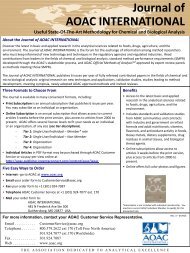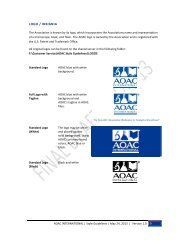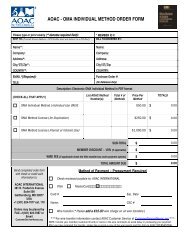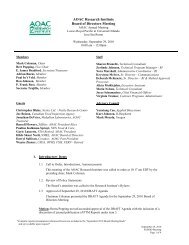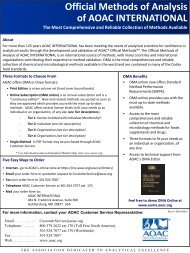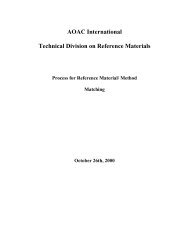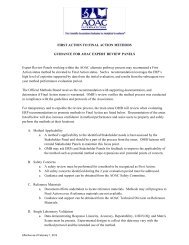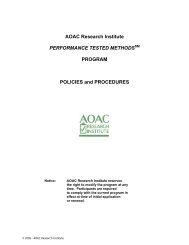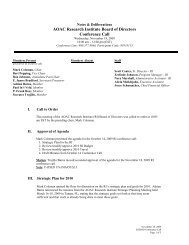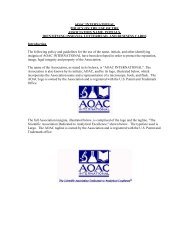Determination of Myo-Inositol - AOAC International
Determination of Myo-Inositol - AOAC International
Determination of Myo-Inositol - AOAC International
You also want an ePaper? Increase the reach of your titles
YUMPU automatically turns print PDFs into web optimized ePapers that Google loves.
6 Schimpf et al.: Journal <strong>of</strong> aoac international Vol. 95, no. 4, 2012<br />
C W = W × 1/0.05 × 1/10 × A 1/V 1 × A 2/V 2<br />
= W × 2 × A 1/V 1 × A 2/V 2<br />
where C W is the concentration <strong>of</strong> the working standard solution<br />
in milligrams per liter; W is the weight, in milligrams, <strong>of</strong><br />
myo-inositol standard weighed; 0.05 is the dilution volume <strong>of</strong><br />
the stock standard in liters; 1/10 is the intermediate standard<br />
dilution (10 to 100 mL); A 1 is the aliquot <strong>of</strong> intermediate<br />
standard used, in milliliters; V 1 is the dilution volume <strong>of</strong> the<br />
working standard in milliliters; A 2 is the aliquot <strong>of</strong> working<br />
standard used, in milliliters, if applicable; and V 2 is the dilution<br />
volume <strong>of</strong> the working standard in milliliters, if applicable.<br />
(b) Preparation <strong>of</strong> standard curve.—For each working<br />
standard concentration, average the peak areas or heights from<br />
each two consecutive sets <strong>of</strong> standards. Prepare a standard<br />
curve by performing linear least squares (regression) on the<br />
concentrations versus the averaged peak areas or heights. A<br />
standard curve must have a correlation <strong>of</strong> at least 0.999 to be<br />
considered acceptable for sample calculations.<br />
At each working standard level, the peak areas or heights <strong>of</strong><br />
standards injected before and after a set <strong>of</strong> samples must not<br />
increase or decrease by more than 7%.<br />
(c) Calculation <strong>of</strong> myo-inositol in samples and controls.—<br />
The concentration <strong>of</strong> myo-inositol in a prepared sample or<br />
control is extrapolated from the standard curve prepared above.<br />
From the diluted, prepared sample concentration, the product<br />
concentration can be calculated:<br />
C p = (C d × D 1)/S<br />
where C p is the concentration <strong>of</strong> myo-inositol in the product<br />
sample or control in milligrams per kilogram; C d is the<br />
concentration <strong>of</strong> myo-inositol in the prepared sample or control<br />
in milligrams per liter; D 1 is the dilution volume in milliliters;<br />
and S is the sample weight in grams.<br />
Total myo-inositol, as defined by <strong>AOAC</strong> SMPR 2011.007 (1),<br />
can be calculated by adding the free myo-inositol and myoinositol<br />
bound as phosphatidylinositol data.<br />
Note: For each set <strong>of</strong> samples, the control result must be<br />
within three standard deviations <strong>of</strong> the control mean.<br />
Reference: J. <strong>AOAC</strong> Int. 95, (future issue)<br />
Results and Discussion<br />
During validation, the average repeatability was 2.0% RSD<br />
and the intermediate precision was 2.5% RSD, as summarized<br />
in Tables 1 and 2. Accuracy was determined by comparison to a<br />
reference microbiological assay as detailed in Table 3 (2). The<br />
instrument LOD and LOQ <strong>of</strong> the method were estimated to be<br />
0.0004 and 0.0013 mg/100 mL, respectively, and correspond to<br />
a free myo-inositol quantitation limit <strong>of</strong> 0.026 mg/100 g.<br />
Although this method has not been fully validated for the<br />
quantitation <strong>of</strong> myo-inositol bound as phosphatidylinositol,<br />
some data have been generated and are summarized in Table 4.<br />
The phosphatidylinositol quantitation limit has been estimated<br />
to be 0.016 mg/100 g.<br />
References<br />
(1) <strong>AOAC</strong> SMPR 2011.007 (2012) J. <strong>AOAC</strong> Int. 95, 295. http://<br />
dx.doi.org/10.5740/jaoac.int.11-0443<br />
(2) Atkin, L., Schultz, A., Williams, W., & Frey, C. (1943) Ind.<br />
Eng. Chem. Anal. Ed., 15, 141–144. http://dx.doi.org/10.1021/<br />
i560114a022



